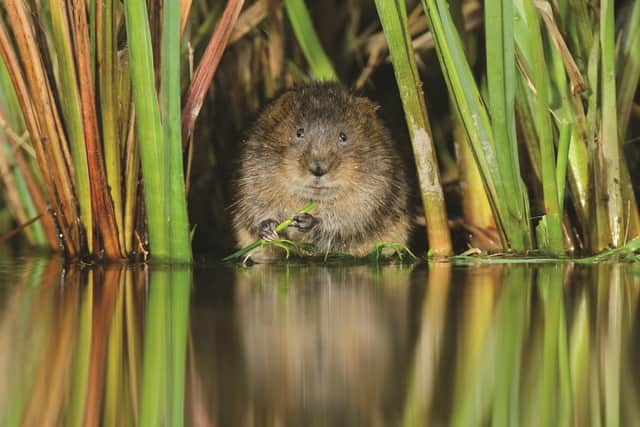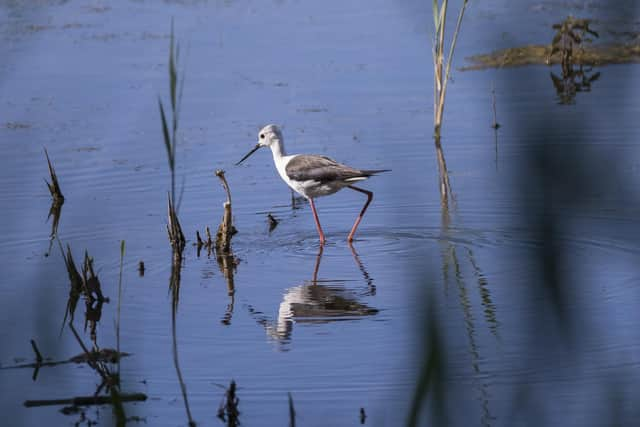Wetland reserves across region welcomed more unusual species of wildlife seeking refuge from hot, dry summer
This year the Yorkshire Wildlife Trust saw a higher number of unusual wildlife visitors on its wetland reserves which are its most important for wildlife habitat.
They provide open water, reed and willow margins, mudbanks, and links to open countryside and woodland.
Advertisement
Hide AdAdvertisement
Hide AdSome of the more unusual visitors this year included rare black-winged stilts which bred at the Trust’s Potteric Carr reserve in South Yorkshire, a first for northern England and much to the delight of wildlife watchers.


As a result in changes of habit this year enforced by weather conditions, The Trust, which has been campaigning for the last 75 years, believes new species like stilts, as well as other visitors including glossy ibises, spoonbill and spotted crake, are likely to be seen more frequently in the coming years as they move north in the search for new feeding and breeding sites.
Potteric Carr in Doncaster recorded just over a third of the UK’s dragonfly and damselfly species, including the willow emerald dragonfly for the first time. The reserve is also home to 902 species of moth, and 20 per cent of Yorkshire’s breeding bitterns.
Characteristic spoonbills have been a more common sight at Potteric Carr this summer and are a more frequent annual visitor to the Trust’s reserve at Kilnsea Wetlands at Spurn.


Advertisement
Hide AdAdvertisement
Hide AdGlossy ibis are a rare visitor to the UK but have been spotted this summer on several Yorkshire Wildlife Trust reserves including Wheldrake Ings, Ripon City Wetlands and Staveley, near Boroughbridge.
Wheldrake Ings floodplain near York is one of the key national sites for shovelers, garganeys and curlews, as well as hosting 50 per cent of the UK breeding population of spotted crake. Osprey have also been spotted there on their migration south in the last week. It’s been a good year too for breeding numbers of very rare willow tit.
Two per cent of the UK’s avocets breed at North Cave Wetlands near Hull, alongside one of Yorkshire’s biggest sand martin colonies.
Wetlands also provide a key habitat for endangered and protected species like great-crested newts, and water voles, which have also declined by 90 per cent in the last 70 years and are nearing extinction in Yorkshire.
Advertisement
Hide AdAdvertisement
Hide AdHowever, the issue now is that new species need to be accommodated alongside existing and often rare or at-risk wildlife species and the UK has lost 90 per cent of its wetland habitat through drainage and building works in the last 100 years.
Across the UK between 2006 and 2012, land-cover maps show over 1,000ha of wetland was converted to artificial surfaces
YWT warns that the more fragmented the remaining wetlands become, the higher the risk is of it drying out and becoming irrecoverable.
On Thursday YWT launched a Wilder Wetlands campaign asking supporters to donate to help fund restoration of reedbeds, bringing back wildlife and having volunteers to carry out surveys on sightings of endangered animals, such as the water vole.
Advertisement
Hide AdAdvertisement
Hide AdChief Executive Rachael Bice said: “Wetlands are incredible for biodiversity – and support more creatures than other type of habitat. They are home to some of our much-loved wildlife throughout the year and offer a lifeline to new species moving north in search of cooler conditions. They play an essential role in the ecosystems we rely on but are becoming increasingly vulnerable as climate change alters rainfall patterns.”
Tony Juniper, Chair of Natural England, added: “During the last 100 years, the UK has lost 90 per cent of its wetlands. This has led to the drastic decline of wildlife and rendered the country more vulnerable to the effects of extreme conditions. Draining fens, desiccating peat bogs, drying floodplains and the claiming of coastal marshes has transformed how our land looks and works. Restoring some of those wetlands could deliver huge benefits for both people and wildlife."
The Trust cares for 25 wetland sites across the county but they are the Trust’s most challenging reserves where water levels can be adjusted and specialist equipment and support is needed. They require constant management and lake margins need to be maintained to provide habitat and prevent reserves from drying out.
It costs more than £100,000 every year to ensure these places remain protected and open for people to enjoy.
The Trust also creates new wetlands from industrial landscapes such as quarries, contributing to nature recovery in new and ways.

